Don't wanna be here? Send us removal request.
Text
12 Advantages and Disadvantages of E-commerce: A Comprehensive Analysis | Imagency Media
Introduction
The rapid growth of e-commerce has transformed how businesses operate, offering both immense opportunities and notable challenges. E-commerce platforms provide a global reach, enhance convenience, and reduce operational costs, yet they also pose concerns about security, competition, and customer trust. Here, we delve into 12 key advantages and disadvantages of e-commerce, offering insight for businesses and consumers alike.

Advantages of E-commerce
Global Reach
E-commerce allows businesses to expand their reach beyond local markets. Online platforms make it possible to sell products and services globally, tapping into new audiences without geographical limitations.
24/7 Availability
One of the significant advantages of e-commerce is its availability round the clock. Customers can shop at any time, providing unparalleled convenience and boosting sales potential for businesses.
Lower Operational Costs
E-commerce businesses often require less physical infrastructure compared to brick-and-mortar stores. Reduced overhead costs, such as rent and utilities, result in greater profit margins.
Personalization and Customer Targeting
Online businesses can use data analytics to tailor marketing strategies. Personalized recommendations and ads enhance customer experiences and increase the likelihood of sales.

Faster Transactions
With e-commerce, transactions are completed quickly. The process of ordering, payment, and delivery is streamlined, allowing customers to receive their purchases efficiently.
Better Inventory Management
E-commerce platforms often integrate advanced inventory management systems, enabling businesses to keep track of stock levels, forecast demand, and reduce excess inventory.
Wide Range of Products
Online stores can offer a more extensive range of products than physical stores due to lower storage constraints. This variety makes it easier for consumers to find specific items.
Customer Reviews and Ratings
E-commerce platforms enable customers to leave reviews and ratings, helping other shoppers make informed purchasing decisions. These reviews also provide businesses with valuable feedback.
Disadvantages of E-commerce
Security and Privacy Concerns
Cybersecurity remains a critical concern for e-commerce businesses. Data breaches, identity theft, and fraudulent activities pose risks for both consumers and companies.
Lack of Personal Interaction
E-commerce lacks the personal touch of in-store shopping. Customers miss out on physically interacting with products and receiving face-to-face customer service, which may deter some buyers.
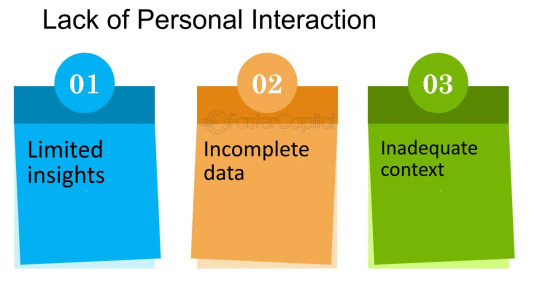
Shipping Costs and Delays
While online shopping offers convenience, shipping costs and delays can frustrate customers. Long delivery times or high shipping fees may dissuade customers from completing purchases.
Competition and Market Saturation
E-commerce markets can quickly become saturated with competitors, making it difficult for new businesses to stand out. This high competition often leads to price wars, reducing profit margins.
Technical Issues
Technical glitches, such as website crashes or payment failures, can lead to a loss of sales. E-commerce businesses rely heavily on smooth, functional platforms, and downtime can significantly impact revenue.
Return and Refund Complexities
Handling returns and refunds is often more complex in e-commerce. The process can be time-consuming and costly, both for businesses and consumers, especially for products that are bulky or perishable.
Trust Issues
Many customers hesitate to shop online due to concerns about product quality, authenticity, and security. Building trust is essential, but it can be challenging, especially for new or lesser-known brands.
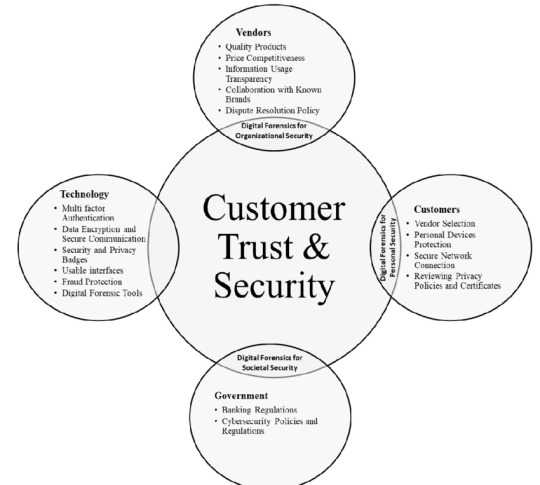
Logistics and Delivery Challenges
Efficient delivery systems are crucial for e-commerce success. Delays, mismanagement, or lack of delivery infrastructure can lead to dissatisfied customers and loss of business.
Conclusion
E-commerce continues to shape the global business landscape, offering unparalleled opportunities for growth and innovation. However, it also presents challenges that businesses must address to thrive in the digital marketplace. By balancing these advantages and disadvantages, companies can harness the full potential of e-commerce while mitigating its risks
CONTACT US
. For consumers, understanding both sides of e-commerce ensures better decision-making and enhanced shopping experiences
0 notes
Text
What is Connective Ecommerce in 2024? Is it Scam | Imagency Media
In the fast-paced world of digital transformation, eCommerce continues to evolve rapidly, driven by advancements in technology and shifting consumer behaviors. In 2024, one of the most significant trends redefining the digital marketplace is connective eCommerce. This paradigm goes beyond traditional online shopping, blending interconnected technologies, platforms, and user experiences to create a seamless, intelligent, and omnipresent commercial ecosystem.

Defining Connective eCommerce
At its core, connective eCommerce refers to a model where various technologies and platforms are integrated to facilitate a fluid, data-driven, and personalized shopping experience. The idea is that instead of siloed platforms where users shop on individual sites or apps, there is a connected web of digital touchpoints—ranging from social media to smart devices—that allow businesses and consumers to engage anywhere and at any time.
This model leverages the power of artificial intelligence (AI), machine learning (ML), the Internet of Things (IoT), and omnichannel strategies to deliver hyper-personalized experiences that anticipate user needs, preferences, and behaviors.
Key Components of Connective eCommerce in 2024
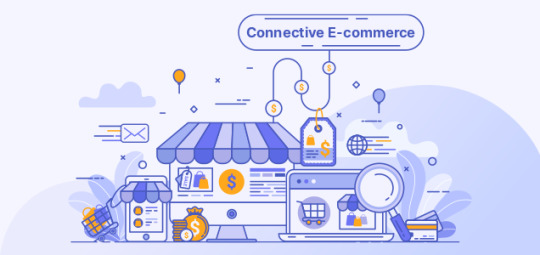
Omnichannel Integration In connective eCommerce, every channel is interconnected. Consumers no longer see distinctions between shopping online, through social media, or in-store. The lines have blurred, and businesses are required to ensure that every touchpoint—whether it’s a website, an app, a social platform, or a physical store—delivers a consistent and cohesive experience. This goes beyond mere availability; it means that customers can start their journey on one platform and seamlessly complete it on another.
AI-Powered Personalization AI is playing a pivotal role in how businesses understand their customers. In 2024, connective eCommerce relies on real-time data processing to deliver hyper-relevant product recommendations, personalized content, and dynamic pricing strategies. AI helps predict what consumers will want next, improving both the shopping experience and customer loyalty.
Social Commerce and Influencer Ecosystems Social platforms have become key players in the connective eCommerce space. With features like in-app shopping and shoppable live streams, platforms like Instagram, TikTok, and Facebook are not only channels for discovery but also for direct transactions. Influencers play a critical role in this ecosystem, driving trends and helping brands build authentic connections with consumers.

Voice and Visual Search Voice search and visual search are emerging as popular tools within the connective eCommerce framework. Voice-enabled devices, such as Amazon Alexa or Google Assistant, are allowing consumers to shop using voice commands, while visual search tools help users find products by snapping a photo or uploading an image. This shift marks the move toward more intuitive and accessible forms of interaction between consumers and digital storefronts.
Augmented Reality (AR) and Virtual Try-Ons AR technology is revolutionizing how consumers shop for products online. Virtual try-ons—be it for clothing, makeup, or even home décor—are becoming mainstream, allowing users to see how products will look or fit in their real lives before making a purchase. This helps reduce return rates and increases consumer confidence in buying products online.
Blockchain and Decentralized Commerce Blockchain technology is influencing eCommerce by introducing decentralized platforms where transactions can occur without intermediaries. Smart contracts are enhancing security and transparency, especially in global trade and high-value transactions, which adds a layer of trust between buyers and sellers.
Benefits of Connective eCommerce
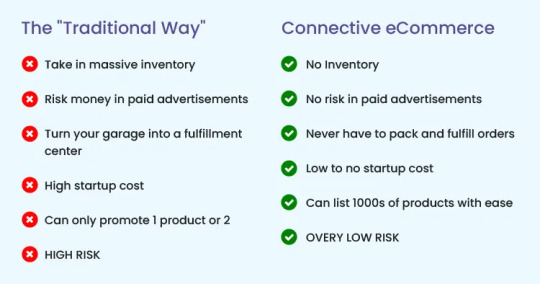
Enhanced Customer Experience: With every channel working together, consumers experience a seamless, convenient, and highly personalized journey, increasing satisfaction and brand loyalty.
Real-Time Data and Insights: Businesses can track customer behavior across multiple platforms, gaining real-time insights that inform better marketing strategies, inventory management, and product development.
Increased Conversion Rates: Personalization powered by AI and ML improves engagement and boosts conversion rates as consumers are presented with products and content tailored specifically to them.
Greater Scalability for Businesses: Connective eCommerce allows companies to expand their reach effortlessly across platforms, opening doors to new markets and customer bases globally.
Challenges to Overcome
While connective eCommerce offers significant advantages, it also presents unique challenges:
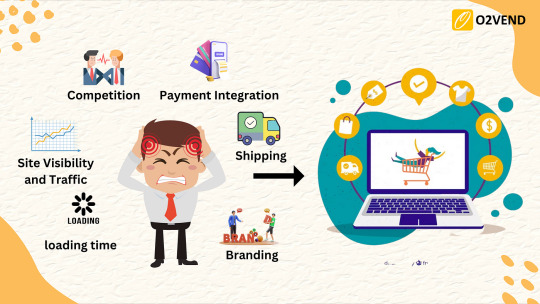
Data Privacy and Security: With an increasing number of platforms and touchpoints, ensuring consumer data privacy and securing transactions remains a major concern.
Integration Complexity: Successfully integrating various platforms, tools, and technologies can be complicated, particularly for small and medium-sized businesses that may not have the resources to implement such solutions seamlessly.
Customer Expectation Management: As experiences become more personalized, consumer expectations will continue to rise. Companies need to ensure they deliver on promises while avoiding over-reliance on algorithms that may not always get it right.
The Future of Connective eCommerce
As we move further into 2024, the connective eCommerce landscape is set to expand, with more companies adopting this model and consumers expecting seamless, interconnected shopping experiences. Innovations like AI-powered personalization, AR, and decentralized commerce will likely grow even more sophisticated, driving a new era of digital commerce that feels both intimate and infinite.
For businesses, the key to thriving in this space lies in leveraging the power of data, embracing new technologies, and crafting strategies that put the consumer at the center of a connected web of experiences. In doing so, they will not only meet the demands of today's digital-savvy shoppers but also set the stage for the future of commerce.
In 2024, connective eCommerce is not just an emerging trend—it’s the future of how we buy and sell, bringing the world of online retail into a new era of hyper-connectivity and intelligent, adaptive shopping experiences.
Contact us
By embracing these innovations, businesses can stay ahead in this highly competitive digital age, creating richer, more meaningful interactions with their customers in ways that were once unimaginable. The connective eCommerce revolution has just begun, and its potential is limitless.
0 notes
Text
How to Become an SEO Expert for E-commerce Business: imagency Media
In today's digital-first world, mastering SEO (Search Engine Optimization) for e-commerce is crucial to building a thriving online business. As an SEO expert, you’ll drive traffic, increase conversions, and boost revenue by ensuring your products are easily found by potential customers. Here’s a comprehensive guide on how to become an SEO expert for e-commerce businesses.

1. Understand E-commerce SEO Basics
SEO for e-commerce is different from traditional SEO because it focuses on optimizing product and category pages for search engines. Here's what to start with:
Keyword Research: This is the foundation of SEO. Learn how to find relevant keywords with commercial intent that customers are using to search for products.
On-Page Optimization: Learn how to optimize titles, meta descriptions, headers, and images for product and category pages.
Content Strategy: Develop content that speaks directly to customer needs, whether it's product descriptions, blogs, or category overviews. High-quality content is essential for ranking well.
2. Focus on Technical SEO
E-commerce websites can be large, making technical SEO a priority. Here’s what you’ll need to learn:

Website Structure: Make sure the site is easy to navigate for both users and search engines. A well-structured site will rank better and provide a better user experience.
Mobile Optimization: With more people shopping on mobile, ensuring your site is mobile-friendly is critical.
Page Speed: Fast-loading pages can make or break your SEO success. Learn how to optimize images, reduce server response times, and leverage browser caching to speed up your site.
URL Structure: Simple, descriptive URLs help search engines and users understand the content of your pages. Aim for clean, keyword-rich URLs.
3. Master On-Site SEO for E-commerce
On-site SEO plays a massive role in determining your rankings and conversions. Focus on these areas:
Product Page Optimization: Learn how to optimize product pages with the right keywords, unique content, and optimized images to ensure each product has a chance to rank.
Internal Linking: Build a solid internal linking strategy to guide users through your website and improve your SEO rankings.
Schema Markup: Use rich snippets to help search engines understand your content better, and provide additional details like product prices, availability, and reviews directly in search results.
4. Off-Page SEO: Build Your Authority
Off-page SEO, such as backlink building, is essential for growing your site's domain authority. Focus on:
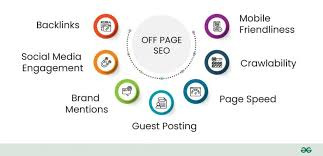
Link Building: Create high-quality, relevant backlinks to your site by connecting with industry influencers, guest blogging, or collaborating with other sites.
Social Media: While not directly linked to SEO, a strong social media presence can indirectly improve your rankings by driving traffic to your site.
Reviews and User-Generated Content: Encourage customer reviews and testimonials, which not only boost SEO but also increase trust with potential buyers.
5. Leverage E-commerce SEO Tools
Using the right tools will save you time and provide insights to refine your SEO strategy:
Google Analytics and Search Console: Understand how users are finding your site, track performance, and identify areas for improvement.
Keyword Research Tools: Use tools like SEMrush, Ahrefs, or Moz to find keywords with strong search volume and manageable competition.
Technical SEO Tools: Use tools like Screaming Frog and Sitebulb to identify and fix technical SEO issues, such as broken links, redirects, and duplicate content.
6. Stay Updated with E-commerce SEO Trends
SEO is ever-evolving, so staying on top of industry updates is crucial. Follow SEO news sources, attend webinars, and take courses to stay informed of algorithm changes and new e-commerce SEO strategies.
7. Understand Local SEO (If Applicable)
If you also have a physical presence or serve local markets, learning local SEO strategies will be essential. Optimize your e-commerce business for Google My Business, local keywords, and location-based search results.
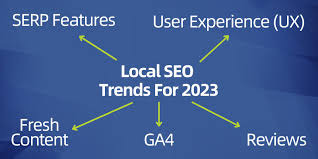
8. Analytics and Continuous Improvement
SEO is not a one-time effort; it’s a continuous process. Regularly monitor your rankings, analyze traffic, and adjust your strategy based on performance data. Being an expert means staying agile and always improving.
Conclusion
Becoming an SEO expert for an e-commerce business requires a mix of technical, analytical, and creative skills. At iMagency Media, we know that mastering SEO is key to driving growth in the e-commerce space. By following these steps and staying committed to learning and optimizing, you’ll be well on your way to becoming an SEO pro who can drive sales and increase visibility for any online store.
Want to learn more?
Contact us at Imagency Media
, where we specialize in driving results through advanced SEO strategies. Let’s make your e-commerce business thrive!
0 notes
Text
8 Best Tools to Supercharge Your Ecommerce Business | Imagency Media
In the dynamic world of ecommerce, staying ahead of the competition requires not only a keen understanding of market trends but also leveraging the right tools to drive growth. Whether you’re looking to enhance your marketing strategies, optimize your store’s performance, or better understand your customers, there’s a tool out there that can help. Here are eight of the best tools to supercharge your ecommerce business:
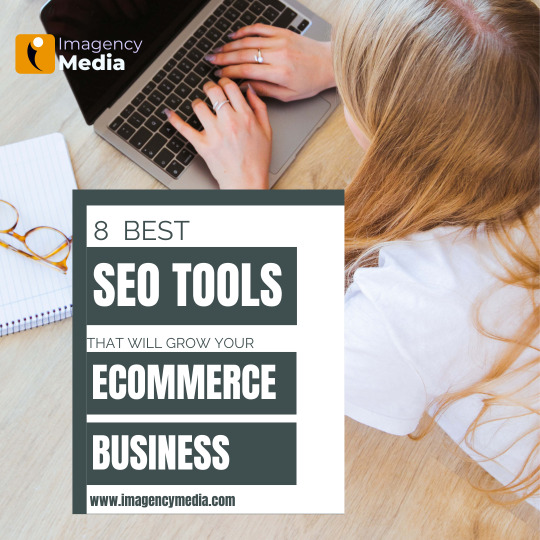
1. Shopify
Why It’s Essential: Shopify is a leading ecommerce platform known for its user-friendly interface, extensive app ecosystem, and robust features. It offers a seamless way to build and manage an online store with customizable templates, secure payment options, and inventory management tools.

Key Features:
Ease of Use: Intuitive drag-and-drop interface.
Customizable Themes: Wide range of professional templates.
App Integration: Access to over 3,000 apps to extend functionality.
Ideal For: Businesses of all sizes looking for a scalable, all-in-one ecommerce solution.
2. Google Analytics
Why It’s Essential: Google Analytics provides deep insights into your website’s performance and customer behavior. By tracking metrics such as traffic sources, user interactions, and conversion rates, you can make data-driven decisions to optimize your ecommerce strategy.
Key Features:
Detailed Reporting: Track traffic, conversions, and user behavior.
Custom Dashboards: Create reports tailored to your business needs.
Integration: Seamlessly integrates with Google Ads and other platforms.
Ideal For: Businesses seeking to understand user behavior and improve marketing effectiveness.
3. SEMrush
Why It’s Essential: SEMrush is a comprehensive SEO tool that helps you improve your search engine rankings and drive organic traffic. Its suite of features includes keyword research, competitive analysis, and site audits, making it an indispensable tool for boosting your ecommerce store’s visibility.

Key Features:
Keyword Research: Discover high-ranking keywords and track your rankings.
Competitive Analysis: Analyze competitors’ strategies and performance.
Site Audit: Identify and fix SEO issues on your website.
Ideal For: Ecommerce businesses focused on enhancing their SEO and online visibility.
4. Mailchimp
Why It’s Essential: Mailchimp is a leading email marketing platform that allows you to create and manage effective email campaigns. With features such as automated workflows, personalized content, and detailed analytics, Mailchimp helps you engage with your customers and drive sales.
Key Features:
Automation: Set up automated email sequences for abandoned carts, welcome series, and more.
Personalization: Tailor emails based on customer behavior and preferences.
Analytics: Track open rates, click-through rates, and conversions.
Ideal For: Businesses looking to enhance customer engagement and drive repeat sales through email marketing.
5. Ahrefs
Why It’s Essential: Ahrefs is a powerful SEO tool that offers in-depth analysis of backlinks, keywords, and content performance. Its extensive database and advanced features make it a go-to resource for improving your website’s search engine rankings and discovering new growth opportunities.

Key Features:
Backlink Analysis: Monitor and analyze your backlink profile.
Keyword Explorer: Find high-potential keywords and track their performance.
Content Research: Identify top-performing content in your niche.
Ideal For: Ecommerce businesses aiming to build high-quality backlinks and optimize their content strategy.
6. Hotjar
Why It’s Essential: Hotjar provides insights into how visitors interact with your website through heatmaps, session recordings, and user surveys. By understanding user behavior and preferences, you can make informed decisions to improve your site’s usability and conversion rates.
Key Features:
Heatmaps: Visualize where users click, scroll, and move on your site.
Session Recordings: Watch recordings of user sessions to identify pain points.
Surveys and Feedback: Collect direct feedback from users to understand their needs.
Ideal For: Businesses looking to enhance user experience and optimize conversion rates.
7. Klaviyo
Why It’s Essential: Klaviyo is an email and SMS marketing platform designed specifically for ecommerce. It offers advanced segmentation, automation, and analytics to help you create highly targeted marketing campaigns that drive revenue and customer loyalty.
Key Features:
Segmentation: Create targeted lists based on customer behavior and preferences.
Automation: Implement complex workflows for abandoned cart emails, post-purchase follow-ups, and more.
Analytics: Measure campaign performance and ROI.
Ideal For: Ecommerce businesses seeking advanced email and SMS marketing solutions.
8. Yotpo
Why It’s Essential: Yotpo is a platform that focuses on customer reviews, ratings, and user-generated content. By leveraging customer feedback and testimonials, Yotpo helps build trust and social proof, which can significantly influence purchasing decisions.
Key Features:
Review Collection: Automate the collection of customer reviews and ratings.
Social Proof: Display user-generated content on your site to enhance credibility.
Analytics: Analyze review trends and customer feedback.
Ideal For: Ecommerce businesses looking to boost trust and social proof through customer reviews and ratings.
Conclusion
Implementing these eight tools can provide your ecommerce business with a significant boost in performance, visibility, and customer engagement. From optimizing your website’s SEO to enhancing your email marketing and understanding user behavior, these tools offer essential functionalities that can drive growth and success in the competitive world of ecommerce. By strategically leveraging these resources, you can create a more effective, data-driven approach to growing your online store and achieving your business goals.
For more insights and expert advice on ecommerce growth strategies, stay tuned to Imagency Media. We’re here to help you navigate the digital landscape and take your business to next level.
Contact us
Email [email protected]
0 notes
Text
Top 13 Fraud Ecommerce Software Solutions: Safeguarding Your Online Store | Imagency Media
In the fast-paced world of digital commerce, safeguarding your online store from fraudulent activities is crucial. As ecommerce continues to grow, so does the sophistication of fraudsters targeting online transactions. At Imagency Media, we’ve curated a list of the top 13 fraud ecommerce software solutions that offer robust protection and help you maintain a secure shopping environment. Here’s a closer look at these top tools:

1. FraudProtect by Signifyd
Signifyd’s FraudProtect provides a comprehensive solution for detecting and preventing fraud. It uses machine learning to analyze transactions in real-time, ensuring only legitimate purchases are processed. With a guarantee of chargeback protection, it’s a go-to choice for many ecommerce businesses.

2. Kount
Kount offers a powerful fraud prevention platform with advanced machine learning and AI. Its solutions help identify and prevent fraudulent transactions while enhancing the customer experience. Kount’s comprehensive analytics and reporting tools are designed to minimize false positives and optimize decision-making.
3. Riskified
Riskified specializes in ecommerce fraud prevention and chargeback management. It leverages AI to assess risk levels and ensure legitimate transactions are approved swiftly. Riskified’s platform also offers a chargeback guarantee, providing financial protection against fraudulent claims.
4. ClearSale
ClearSale combines machine learning with a team of fraud analysts to offer a multi-layered fraud prevention solution. It provides real-time transaction analysis, reducing false declines and improving conversion rates. ClearSale’s expertise in ecommerce fraud helps businesses protect their revenue effectively.
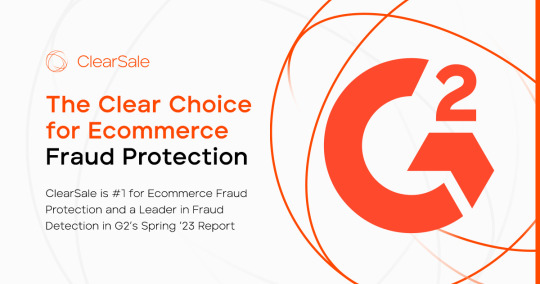
5. Forter
Forter’s fraud prevention platform uses real-time data and behavioral analytics to detect fraud. Its technology adapts to emerging threats, ensuring continuous protection. Forter’s focus on reducing friction for legitimate customers while blocking fraudulent transactions makes it a valuable tool for ecommerce businesses.
6. Sift
Sift offers a comprehensive suite of fraud prevention tools that utilize machine learning to detect and prevent fraudulent activities. Its platform provides detailed insights into transaction patterns and helps businesses implement proactive measures against fraud.
7. Shiptimize
Shiptimize provides a robust fraud prevention solution designed for ecommerce platforms. It offers real-time risk assessment and transaction monitoring, helping businesses identify and mitigate fraudulent activities before they impact their operations.
**8. Signifyd
Signifyd’s end-to-end fraud prevention solution offers real-time decisioning powered by AI. Its platform not only detects fraud but also guarantees chargeback protection, ensuring peace of mind for ecommerce businesses.
**9. The Fraud Practice
The Fraud Practice offers a range of fraud prevention services tailored to ecommerce. Its tools include transaction monitoring, fraud analysis, and risk management, all designed to protect online retailers from fraud and chargebacks.
**10. CyberSource
CyberSource provides a comprehensive suite of fraud prevention solutions with advanced machine learning and risk management capabilities. Its platform integrates with various ecommerce systems and offers detailed reporting to help businesses make informed decisions.
**11. Acapture
Acapture’s fraud prevention tools are designed to enhance the customer experience while protecting against fraudulent activities. Its solution includes real-time transaction analysis and risk management, making it a valuable asset for ecommerce businesses.
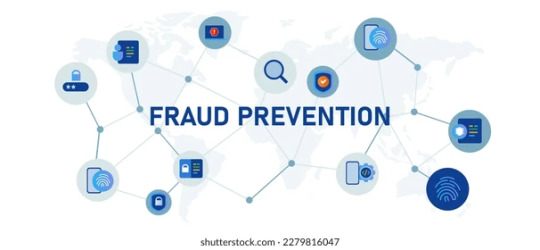
**12. Jumio
Jumio specializes in identity verification and fraud prevention. Its platform uses AI and biometric technology to verify identities and detect fraudulent activities, ensuring secure transactions and protecting against identity fraud.
**13. Riskified
Riskified’s fraud prevention solution offers real-time transaction analysis and risk management powered by AI. Its platform includes chargeback protection and is designed to enhance the customer experience while mitigating fraud risks.
By implementing these top fraud ecommerce software solutions, businesses can effectively protect themselves against fraudulent activities and ensure a secure online shopping experience for their customers. As ecommerce continues to evolve, staying ahead of fraud trends and utilizing advanced tools is essential for maintaining trust and safeguarding your revenue.
Contact us
At Imagency Media, we recommend evaluating these solutions to find the best fit for your business needs and ensuring your online store remains secure and resilient.
#digital marketing#social media marketing#ecommerce#ebusiness#online shopping#online store#software#solutions#fraud
0 notes
Text
Why B2C Ecommerce Business Convenience ?| Imagency Media
In today's fast-paced digital landscape, convenience has become the cornerstone of successful B2C eCommerce businesses. Consumers expect seamless, hassle-free experiences from the moment they land on your site to the point they receive their purchase. At Imagency Media, we recognize that delivering this level of convenience is not just about meeting expectations—it's about exceeding them and creating a memorable shopping experience that fosters loyalty and drives growth.

Streamlined Shopping Experiences
One of the key elements of convenience in eCommerce is streamlined navigation. A user-friendly interface that allows customers to find products quickly and effortlessly can significantly impact their shopping experience. Features like intuitive search bars, clear category labels, and advanced filtering options help customers locate exactly what they need with minimal effort.

Effortless Checkout Processes
A smooth checkout process is critical in reducing cart abandonment rates. Simplified payment options, such as digital wallets and one-click payments, combined with transparent shipping information and easy return policies, can make a world of difference. Ensuring that the checkout process is both quick and secure builds trust and enhances customer satisfaction.
Personalized Shopping
Personalization is another vital aspect of convenience. Leveraging data to offer tailored product recommendations, targeted promotions, and personalized content can significantly enhance the shopping experience. By understanding your customers' preferences and behavior, you can provide a shopping journey that feels bespoke and engaging.

Reliable Customer Support
Even with the most efficient systems in place, there will always be questions or issues. Offering reliable and accessible customer support through various channels—such as live chat, email, and phone—ensures that help is readily available when needed. This not only resolves issues promptly but also strengthens customer trust a

nd loyalty.
Seamless Integration
Integrating your eCommerce platform with other systems, such as inventory management and CRM tools, ensures that all processes work in harmony. This integration minimizes errors, improves efficiency, and provides a cohesive experience from order placement to delivery.
The Imagency Media Approach
At Imagency Media, we specialize in creating eCommerce solutions that prioritize convenience without compromising on quality. Our team is dedicated to optimizing every aspect of the online shopping experience, ensuring that your business not only meets but exceeds customer expectations.
Ready to enhance your eCommerce convenience?
Whether you’re looking to revamp your existing platform or start from scratch, Imagency Media is here to help. Our expertise and tailored solutions can elevate your business and provide a seamless shopping experience for your customers.
Contact Us
For more information on how we can assist you in achieving unparalleled convenience in your B2C eCommerce business, get in touch with us today. Our team is ready to discuss your needs and provide a customized plan to help your business thrive in the digital marketplace.
Email: [email protected] Phone: 1-800-123-4567 Website: www.imagencymedia.com
#business#selling#online store#online shopping#ecommerce#ebusiness#digital marketing#marketing#social media marketing
4 notes
·
View notes
Text
E-Commerce vs. E-Business | Imagency Media
In the ever-evolving digital landscape, understanding the distinction between e-commerce and e-business is crucial for modern businesses, especially for those like Imagency Media that focus on e-commerce growth. While the two terms are often used interchangeably, they serve distinct roles within the business ecosystem. Here’s a simplified breakdown to clarify their unique functions:
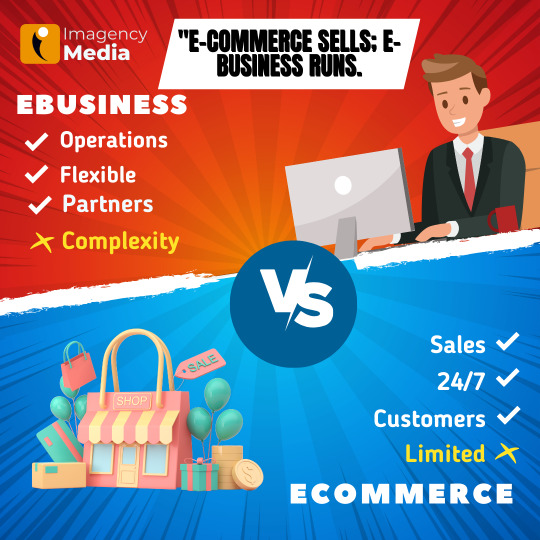
What is E-Commerce?
E-commerce refers specifically to the buying and selling of products or services online. It’s the digital marketplace where transactions between businesses and consumers happen. Think of it as the storefront of your business — just virtual. At Imagency Media, e-commerce is all about providing clients with seamless platforms to showcase and sell their products to a global audience.

Advantages of E-Commerce:
Sales: Directly focused on selling goods and services online.
Reach: Breaks geographical barriers, allowing global sales.
24/7: Constant availability, providing convenience for customers.
Tracking: Offers detailed analytics on customer behavior and transactions.
Disadvantage: Limited scope, focusing only on transactions.
What is E-Business?
E-business, on the other hand, encompasses the entire business process carried out electronically. While e-commerce is a part of e-business, e-business goes beyond selling. It includes internal processes like supply chain management, customer service, and even HR functions, all digitized to improve efficiency and communication.
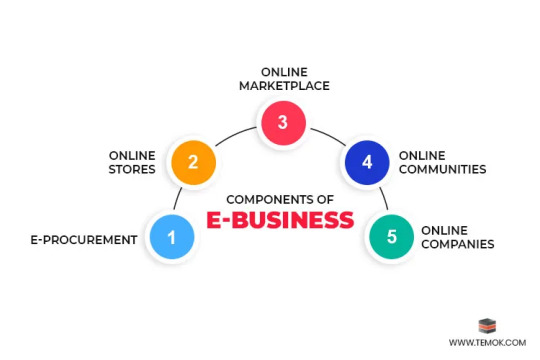
Advantages of E-Business:
Automation: Streamlines and automates business processes.
Communication: Enhances interactions with suppliers and partners.
Efficiency: Optimizes internal operations.
Agility: Improves business adaptability in dynamic markets.
Disadvantage: Complexity in managing multiple digital systems.
Key Takeaway:

In short, e-commerce sells, while e-business runs. Both are essential for a modern business, but their scope and focus differ. At Imagency Media, we harness the power of e-commerce to help businesses reach more customers and close more sales while understanding the broader e-business ecosystem to ensure smooth operational flow.
Contact us
Whether you're looking to boost your sales or streamline your business processes, recognizing this difference is vital to your success.
1 note
·
View note